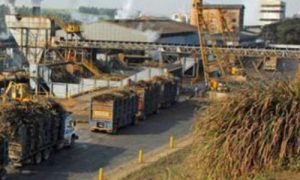Global sugar surplus depends on India

Despite a forecasted global sugar surplus for the 2024/25 season, prices remain resilient due to concerns about the CS Brazil crop, particularly the effects of drought and fires. Production estimates for Brazil are lower than last year, and while the crop’s final size remains uncertain, it is still expected to be substantial. Other regions like Thailand and the EU are experiencing stronger production, which should cap price increases. Indian crop uncertainties also add volatility, as export policies will depend on domestic output.
Sugar market in surplus
Despite expectations for a global surplus in the sugar market in the 2024/25 season, sugar prices have held up relatively well. This has been largely due to concerns over the CS Brazil crop where drought conditions and fires in cane fields raised risks not only for the 2024/25 crop but also the 2025/26 crop. Rainfall more recently has eased some concerns for the next crop.
However, the expected size of the surplus has fallen as we have moved through the year, with the global market now expected to see a surplus of a little over 4mt in 2024/25.
While there are clear supply risks which leaves uncertainty over the expected surplus, we believe stronger Thai, EU and potentially Indian production should cap upside in prices. We would expect the market to come under renewed pressure once the CS Brazil 2025/26 harvest gets underway. Furthermore, if India allows exports over the course of 2025 (which could happen in the first quarter), it will provide further downside to prices.
As a result, we expect No.11 raw sugar to average USc20.30/lb over the course of 2025.
CS Brazil crop worries possibly overdone
The CS Brazil crop is winding down as the region moves closer to the off crop. The region is expected to crush around 595mt of cane, yielding a little over 39mt of sugar production. The sugar mix has been strong this season at more than 48%, with sugar prices remaining at a healthy premium to domestic hydrous ethanol prices. This is down on last year, where almost 655mt of cane was crushed and more than 42.4mt of sugar produced. A smaller crop was expected, however estimates have edged lower as we have moved through the season. But at more than 39mt, it is still the second largest amount of sugar produced in a season in CS Brazil.
However, with the 2024/25 CS Brazil crop largely complete, attention will be turning to the 2025/26 crop, which officially starts in April. There is a fair amount of uncertainty over how this crop will develop due to the fires seen in cane fields this year. Large parts of CS Brazil have suffered from drought, although the region has had rain more recently as we head into the rainy season. If normal weather conditions continue, this should allow agricultural yields to recover and see the industry crushing more cane than in the 2024/25 harvest.
Furthermore, sugar continues to trade at a healthy premium to hydrous ethanol in Brazil, so mills should continue to push for a maximum sugar mix. The more recent weakness in the Brazilian real (BRL) should only help this dynamic. As a result, 2025/26 sugar output could total somewhere in the region of 42-43mt.
The weakness in the BRL means that sugar prices in local terms are attractive for Brazilian producers. However, the more recent weakness in the BRL does not appear to have brought in that much producer pricing. In fact, both the producer short and the swap dealer short are below average for this time of year in No.11 raw sugar.
Indian crop and export uncertainty
The 2024/25 Indian harvest is now well underway, although the harvest did get off to a slow start – particularly in Maharashtra, owing to local elections. Sugar output over the first two months of the 2024/25 marketing year stood at 2.79mt, down more than 35% year-on-year.
The Indian Sugar and Bio-Energy Manufacturers Association (ISMA) forecasts that the 2024/25 crop will total 29.3mt, down from 31.96mt in the previous season. This is after taking into account the diversion to ethanol. These lower estimates are partly on the back of lower acreage estimates following a poorer monsoon season in 2023 ahead of the previous crop. However, some are forecasting that acreage will be largely unchanged YoY, while yields are also expected to improve following a better 2024 monsoon season, potentially leading to a crop of somewhere in the region of 32-33mt after taking into consideration diversion to ethanol.
Clearly, the large difference in forecasts suggest plenty of uncertainty in the crop. It also means if production comes in towards some of the lower estimates out there, it would be enough to almost wipe out the global surplus we expect this year.
The size of the Indian crop will also be important in determining whether the government will allow sugar exports this season. A crop towards the lower end of the range would reduce the probability or at least push back the potential for exports until much later in the season, once there is full clarity on domestic supply. The government also wants to ensure that there is enough supply to hit its 20% ethanol blending mandate by 2025. While theoretical (given the government has not issued export quotas), the export parity for Indian sugar is wide open.
Strong recovery in Thai crop
In Thailand, the 2024/25 crush should be getting underway now and the crop this season is expected to see a fairly strong recovery. Higher cane prices would have led to higher plantings, while better weather over the rainy season this year should prove beneficial to agricultural yields.
With these elements combined, we should see the cane crush exceed 100mt, up from around 85mt in 2023/24. This is estimated to see sugar production exceed 11mt compared to a little more than 8.5mt last season. Stronger Thai output should translate to strong Thai exports in the first quarter of 2025, offering some relief to a period we usually see seasonal tightness in the global sugar market due to it being the CS Brazil off crop.
EU production continues to tick higher
The EU sugar market continues to look increasingly comfortable, reflected in the weakness in regional prices. This has been largely driven by a recovery in EU output in 2023/24 and the expectation that output will continue to increase in the 2024/25 season, which is expected to see EU ending stocks edging higher. Production in the EU over 2024/25 is forecast to increase by around 1mt YoY to 16.6mt, which is driven by a combination of higher area and also an improvement in yields. French beet yields are expected to come under pressure – but this should be offset by larger area.
Weakness in the whites premium
While the sugar market has seen a fair amount of strength in the flat price this year, there is a part of the market which is signalling weakness. The white sugar premium – the spread between refined white sugar and raw sugar – has weakened towards $80/t, having traded above $150/t earlier in the year. This is the weakest the premium has been since late 2021.
Part of this weakness will be due to expectations of stronger Thai and EU output. A weaker premium should also see standalone refineries reducing operating rates, which would mean reduced demand for raw sugar. The key downside risk to the whites premium is if the Indian government allows exports at some stage through 2025.
To read more about Sugar Industry continue reading Agriinsite.com
Source : ING















